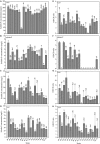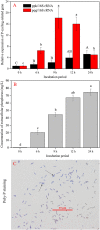Isolation and Characterization of Phosphorus Solubilizing Bacteria With Multiple Phosphorus Sources Utilizing Capability and Their Potential for Lead Immobilization in Soil
- PMID: 32390988
- PMCID: PMC7190802
- DOI: 10.3389/fmicb.2020.00752
Isolation and Characterization of Phosphorus Solubilizing Bacteria With Multiple Phosphorus Sources Utilizing Capability and Their Potential for Lead Immobilization in Soil
Abstract
Phosphorus solubilizing bacteria (PSB) can promote the level of plant-absorbable phosphorus (P) in agro-ecosystems. However, little attention has been paid to PSB harboring abilities in utilizing multiple phosphorus sources and their potentials for heavy metal immobilization. In this study, we applied the strategy of stepwise acclimation by using Ca3(PO4)2, phytate, FePO4, and AlPO4 as sole P source. We gained 18 PSB possessing abilities of multiple P sources utilization, and these bacteria belonged to eight genera (Acinetobacter, Pseudomonas, Massilia, Bacillus, Arthrobacter, Stenotrophomonas, Ochrobactrum, and Cupriavidus), and clustered to two apparent parts: Gram-positive bacteria and Gram-negative bacteria. The isolate of Acinetobacter pittii gp-1 presented good performance for utilizing Ca3(PO4)2, FePO4, AlPO4, and phytate, with corresponding P solubilizing levels were 250.77, 46.10, 81.99, and 7.91 mg/L PO4 3--P, respectively. The PSB A. pittii gp-1 exhibited good performance for solubilizing tricalcium phosphate in soil incubation experiments, with the highest values of water soluble P and available P were 0.80 and 1.64 mg/L, respectively. Additionally, the addition of A. pittii gp-1 could promote the immobilization of lead (Pb), and the highest Pb immobilization efficiency reached 23%. Simultaneously, we found the increases in abundances of both alkaline phosphatase gene (phoD) and β-propeller phytase gene (bpp) in strain gp-1 added soils. Besides, we observed the expression up-regulation of both pyrroloquinoline quinone gene (pqq) and polyphosphate kinases gene (ppk), with the highest relative expression levels of 18.18 and 5.23, respectively. We also found the polyphosphate particles using granule staining. To our knowledge, our findings first suggest that the solubilizing of tricalcium phosphate by phosphorus solubilizing bacterium belonging to Acinetobacter is coupled with the synthesis of polyphosphate. Taken together, A. pittii gp-1 could be a good candidate in improving soil fertility and quality.
Keywords: Acinetobacter pittii gp-1; P-cycling-related gene; Pb immobilization; multiple phosphorus source utilizing capacity; phosphorus solubilizing bacteria; ppk and pqq genes.
Copyright © 2020 Wan, Qin, Wu, Zuo, He, Tan, Wang and He.
Figures







Similar articles
-
Distribution of Culturable Phosphate-Solubilizing Bacteria in Soil Aggregates and Their Potential for Phosphorus Acquisition.Microbiol Spectr. 2022 Jun 29;10(3):e0029022. doi: 10.1128/spectrum.00290-22. Epub 2022 May 10. Microbiol Spectr. 2022. PMID: 35536021 Free PMC article.
-
Phosphate-Solubilizing Bacterium Acinetobacter pittii gp-1 Affects Rhizosphere Bacterial Community to Alleviate Soil Phosphorus Limitation for Growth of Soybean (Glycine max).Front Microbiol. 2021 Sep 24;12:737116. doi: 10.3389/fmicb.2021.737116. eCollection 2021. Front Microbiol. 2021. PMID: 34630363 Free PMC article.
-
[Screening and molecular identification of phosphate-solubilizing bacteria in rhizosphere soils in Hainan ecosystem].Wei Sheng Wu Xue Bao. 2009 Jan;49(1):64-71. Wei Sheng Wu Xue Bao. 2009. PMID: 19388266 Chinese.
-
Phosphate-Solubilizing Bacteria: Advances in Their Physiology, Molecular Mechanisms and Microbial Community Effects.Microorganisms. 2023 Dec 1;11(12):2904. doi: 10.3390/microorganisms11122904. Microorganisms. 2023. PMID: 38138048 Free PMC article. Review.
-
Phosphate-solubilizing bacteria: Their agroecological function and optimistic application for enhancing agro-productivity.Sci Total Environ. 2023 Nov 25;901:166468. doi: 10.1016/j.scitotenv.2023.166468. Epub 2023 Aug 22. Sci Total Environ. 2023. PMID: 37619729 Review.
Cited by
-
Purpureocillium lilacinum SBF054: Endophytic in Phaseolus vulgaris, Glycine max, and Helianthus annuus; Antagonistic to Rhizoctonia solani; and Virulent to Euschistus heros.Microorganisms. 2024 May 29;12(6):1100. doi: 10.3390/microorganisms12061100. Microorganisms. 2024. PMID: 38930483 Free PMC article.
-
Seed bio-priming with tri-species consortia of phosphate solubilizing rhizobacteria (PSR) and its effect on plant growth promotion.Heliyon. 2020 Dec 15;6(12):e05701. doi: 10.1016/j.heliyon.2020.e05701. eCollection 2020 Dec. Heliyon. 2020. PMID: 33367127 Free PMC article.
-
Distribution of Culturable Phosphate-Solubilizing Bacteria in Soil Aggregates and Their Potential for Phosphorus Acquisition.Microbiol Spectr. 2022 Jun 29;10(3):e0029022. doi: 10.1128/spectrum.00290-22. Epub 2022 May 10. Microbiol Spectr. 2022. PMID: 35536021 Free PMC article.
-
Genomic Analysis of the Endophytic Stenotrophomonas Strain 169 Reveals Features Related to Plant-Growth Promotion and Stress Tolerance.Front Microbiol. 2021 Jun 16;12:687463. doi: 10.3389/fmicb.2021.687463. eCollection 2021. Front Microbiol. 2021. PMID: 34220780 Free PMC article.
-
Bio-priming with a Novel Plant Growth-Promoting Acinetobacter indicus Strain Alleviates Arsenic-Fluoride Co-toxicity in Rice by Modulating the Physiome and Micronutrient Homeostasis.Appl Biochem Biotechnol. 2023 Nov;195(11):6441-6464. doi: 10.1007/s12010-023-04410-3. Epub 2023 Mar 4. Appl Biochem Biotechnol. 2023. PMID: 36870026
References
-
- Bhattacharyya P., Nayak A. K., Shahid M., Tripathi R., Mohanty S., Kumar A., et al. (2015). Effects of 42-year long-term fertilizer management on soil phosphorus availability, fractionation, adsorption-desorption isotherm and plant uptake in flooded tropical rice. Crop J. 3 387–395. 10.1016/j.cj.2015.03.009 - DOI
-
- Chen Y., Fan J. B., Du L., Xu H., Zhang Q. H., He Y. Q. (2014). The application of phosphate solubilizing endophyte Pantoea dispersa triggers the microbial community in red acidic soil. Appl. Soil Ecol. 84 235–244. 10.1016/j.apsoil.2014.05.014 - DOI
LinkOut - more resources
Full Text Sources
Molecular Biology Databases

